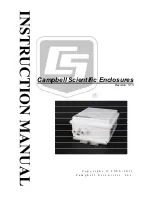
Section 363-765-100
Revision 01
Page 7
TABLE 7. RT ENCLOSURE FUSE
Fuse
Type
Function
F1
GMT 2A
Provides over-current protection between RT enclosure and local -48 V
dc battery. This fuse is not used when the RT is line powered from the
COT.
C. INSTALLATION AND TEST
7. UNPACKING
7.01
Upon receipt of the equipment, proceed as
follows:
1. Unpack each container and visually inspect it
for signs of damage. If the equipment has
been damaged in transit, immediately report
the extent of damage to the transportation
company and to PairGain. Order replacement
equipment if necessary.
2. Check the contents versus the packing list to
ensure complete and accurate shipment. If
the shipment is short or irregular, contact
PairGain as described in Section 4. If you
must store the equipment for a prolonged
period, store the equipment in its original
container.
8. INSTALLATION REQUIREMENTS
8.01
The following installation requirements apply:
1.
Environmental Considerations. The RT is
designed to operate in an outside plant
environment. It can operate in a temperature
range of -40°C to +65°C and a humidity
range of 5% to 95% (non-condensing).
2.
Mounting. The RT enclosure is equipped
with external mounting flanges with 3/8-inch
holes for pole or wall mounting. The
technician must provide the appropriate
mounting hardware.
3.
Power. The RT derives its power from the
HDSL lines connected to the COT shelf in
the central office.
4.
HDSL Lines. Two HDSL pairs are
terminated in the RT enclosure.
5.
Subscriber Lines. One 32-pair, Amphenol
connector (male) is provided for extending
the subscriber lines from the RT to a
suitable termination block. If the RT is
mounted outside, then the subscriber lines
may require primary protection using gas
tube (or solid state) protectors.
6.
Metallic Test Pair. One (optional) metallic
test pair for subscriber line testing is
terminated in the RT enclosure.
9. MOUNTING
9.01
The FRE-765 RT Enclosure may be mounted on
a pole or wall. Local practices should be
followed to ensure a secure mounting. The RT enclosure
should be mounted such that there is easy access to the
cable entry points on the bottom of the enclosure and
there is adequate room to open the door completely to
facilitate installation.
10. WIRING
10.01
All cabling into the RT Enclosure is through the
bottom entry points. Perform the wiring
procedures described in Table 8.
11. TURN-UP AND TESTING
11.01
Refer to the COT Line Unit Technical Practice or
RT Line Unit Technical Practice for complete
COT and RT turn-up and testing procedure.
12. TROUBLESHOOTING
12.01
Refer to the COT Line Unit Technical Practice or
RT Line Unit Technical Practice for complete
COT and RT troubleshooting procedures.


























